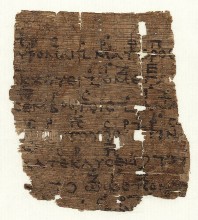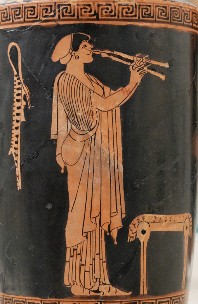5.4.1: Ancient Greece- The Iliad
- Page ID
- 90712
In Chapter 4, we explored the origins of European opera and the influence of ancient Greek music on the genre. One of the aspects of ancient Greek music that directly inspired the creation of opera was the notion that ancient Greek poetry and drama were sung in their entirety, not spoken (like what is witnessed when attending a Shakespearean play). Although the lack of surviving musical notation from the period leaves us with little evidence as to how ancient Greek drama actually sounded, the few surviving musical fragments and our theoretical knowledge of both music and poetic recitation in ancient Greece provide us with a good idea as to how Greek poetry and drama might have been sung.
Greek drama grew out of a tradition of community gathering and singing, particularly during festivals and sacrifices in praise of gods such as Dionysus or Apollo. To accompany these celebrations, there would be songs of praise setting dramatic poetry pertaining to the celebrated figures or other mythical beings. Although the tradition began with the community singing these songs in a chorus setting, eventually solo singers would emerge from the chorus to act out the part of the god or hero, while the chorus acted as a narrator or took part in sung dialogue with the soloist. Thus, the beginnings of Greek theatre emerged, and the solo actor and chorus dynamic became a staple in the Greek theatre tradition.
Poetic Meter and Sung Recitation
Many Greek dramas have been preserved through their texts, and many have become well-known classics in today’s world. However, through further study of some of the fragments of poetry from ancient Greece, it is now believed that the poetry and dramas were meant to be performed in musical settings. In later Greek dramas, melodic notation has preserved the ancient sung melodies, but there has yet to be found any surviving form of rhythmic notation from this time. It is understood, however, that the rhythm of the sung words was based off the prosody or meter of the poetry. Poetic meter, similar to musical meter, structures the rhythm of spoken (or in this case, sung) prose. A common example of a poetic meter used in Greek drama is dactylic hexameter. In this type of meter, a poetic phrase is divided into six feet (similar to measures in musical notation). Each foot is divided by what is called a dactyl, a long syllable followed by two short syllables (in this type of meter, a dactyl can also be substituted by a spondee, or two long syllables). When recited, the spoken or sung phrase would follow this pattern of long and short syllables, producing a steady rhythm:
(long-short-short) (long-short-short) (long-short-short) (long-short-short) (long-short-short) (long-short-short)
One famous example of a Greek epic in dactylic hexameter is Homer’s Iliad. The Iliad was written to be accompanied by a four-stringed lyre, and although there are no surviving fragments of actual melodic notation attached to the poetry, it is believed that this epic was meant to be sung in its entirety. In our example, an interpretation of a passage from the Iliad10 by classicist Stefan Hagel, the consistent “long-short-short” rhythm of the dactylic hexameter is apparent. The sung melody is an improvisation based on the inflection of the text; for instance, if the approximate pitch goes up at the end of the word in natural speech, it likewise ascends to a higher note when sung. As in this example, the melodies of poetic recitations were probably folk-like in nature: that is to say, simple and repetitive. The tempo is set by the content of the text. In scenes of heightened tension the music may be fast, while the music used in describing a more solemn scene may be slow.
|
10. The Iliad Performance: Stefan Hagel (2017) |
Although most of the musical elements of Homer’s dramas are uncertain and therefore must be left up to the performer’s interpretation, which is based on the nature of the text, there are several surviving fragments of poetry and drama written in stone or on papyrus that are accompanied by written musical notation. The ancient Greeks had a system of musical notation in which a pitch would be associated with a particular symbol, usually a symbol from the Greek alphabet. This pitch’s symbol would be written above the syllable of the sung word. One of the few surviving fragments of music, written on papyrus, comes from Euripides’s Orestes. The play tells the story of Orestes, the son of Clytemnestra and Agamemnon, who kills his mother to seek revenge for his father’s death. The fragment is of a song sung by the chorus in unison. They sing of Orestes being chased by his mother’s furies, or spirits of revenge.


Unlike the simple, repetitive melody that Homer’s words would have most likely been performed to, the melody of the Orestes chorus,11 believed to be composed by Euripides himself, is through-composed. The melody also differs from the Homeric poetry in that it doesn’t follow the natural inflection of the spoken Greek text, though there are instances in which important words are sounded at a higher pitch for emphasis. The rhythm follows the dochmiac poetic meter, a meter typically used to convey agitation, anxiety, or distress. This sense of distress can certainly be heard in our example. There, we also see the choir accompanied by an aulos, a double pipe instrument. This instrument was often used to accompany choruses in dramatic productions.

Ancient Greek epic recitation can be contrasted with this surviving vocal composition, which does not follow the natural inflections of Greek text. As is evident through this performance, with musical translation and a bit of reconstruction this ancient music is now able to be performed with near-perfect historical accuracy. The revival of the music alongside the poetry sheds a new light on the emotional impact of this drama on ancient audiences and allows modern audiences a glimpse of this once-forgotten art that inspired future forms of sung drama.


